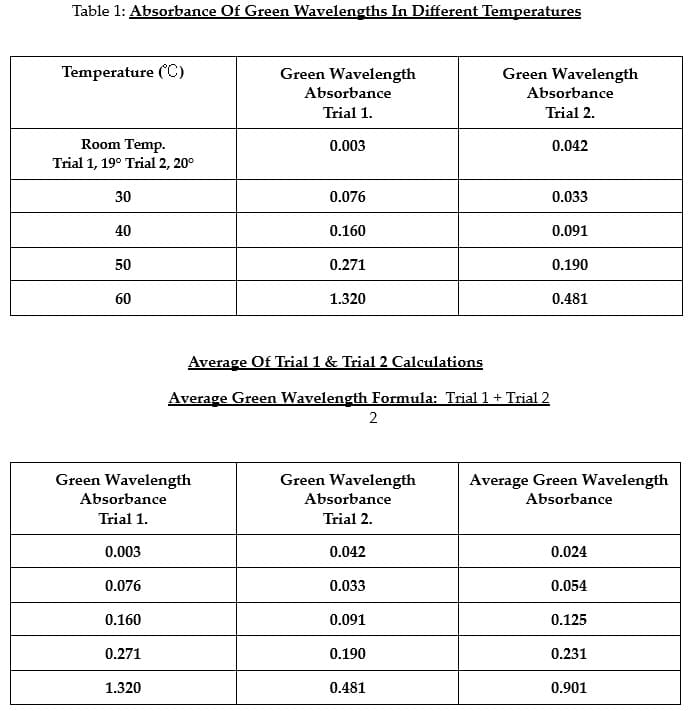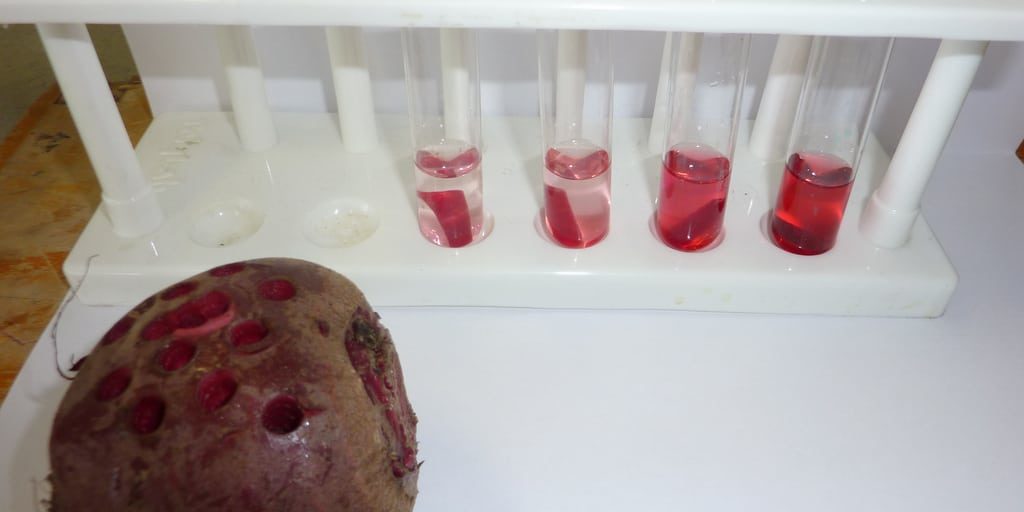Permeability of a cell to solutes in an aqueous solution depends upon the physical and chemical make-up of the membrane. The maintenance of the living cell depends upon the continued presence and functioning of a selectively permeable membrane. If the nature of the membrane is altered in any way, this may affect it’s permeability and thus the properties of the cell of which it is a part. Irreversible changes in the membrane’s permeability usually lead to the cell’s death. In this experiment, we will study the effects of changes in the environmental conditions on the permeability of living beetroot cells.
Roots of beet (Beta vulgaris ) contain large amounts of a reddish pigment called betacyanin, localized almost entirely in the large central vacuoles of the cells. Betacyanin in healthy cells remains inside the vacuoles, surrounded by a vacuolar membrane called a tonoplast. The entire cell is surrounded by a cellular or plasma membrane. Environmental stresses can damage the membranes, allowing betacyanin to leak through the tonoplast and plasma membrane. This leakage of betacyanin will produce a red colour in the water surrounding the stressed beet. Thus the degree of membrane damage can be determined by monitoring the intensity of the colour leakage resulting from a treatment.
Objectives
By the end of this investigation, the student should be able to:
Describe the effect of heat on the permeability of beetroot tissue.
Relate the theory of membrane structure and collision theory, with the observations made during this activity.
Purpose: The essential purpose of this lab is to see the effect that temperature has on a beetroot’s tissue and to find how the permeability of the beetroot’s membrane is affected by environmental
changes. Additionally, we conducted this lab to identify a beetroot’s cells reaction to betacyanin, the red dye held in by the beetroot’s cells. This is done by seeing how much green wavelength that comes from dyed water. The variables we are testing are temperature, the independent value, and the red color surrounding the water, indicating betacyanin leakage from the beetroot cells.
Materials
- Masking tape
- Thermometer
- 1 test tube holder 50 ml beaker
- 10 ml pipette
- 1 test tube rack
- Beets Pipette pump
- 6 thermostatic water baths
- Scalpel Glass stirring rod
- Safety goggles
- Watch
- Colorimeter
- Distilled water
- 3 cuvettes GLX data recorder
- 12 test tubes
Preparation of Beetroot Sections: With the aid of a scalpel, remove the top vegetative portion and the base of a beetroot (see Figure 1). Carefully bore out several cores of beetroot tissue using a cork borer. Use a scalpel to slice the cylindrical cores into 5 mm sections. You will need a total of 3 sections for each temperature used in the lab (make every effort to cut the sections accurately). All of the sections should be placed in a beaker of distilled water at room temperature to remove the betacyanin from the injured cells on the surface.

Note: 6 water baths will be set at different temperatures (room temperature 20C, 30C, 40C, 50C, 60C, and 70C). One member of each group will be responsible for cutting the beet discs while the others will measure 10.0 ml of distilled water at the appropriate temperature into the labelled test tubes. One labelled test tube is placed into each of the 6 water baths for each group. Be sure that you can identify your group’s test tubes.
- Six water baths have been prepared at the following temperatures (20°C), 30°C, 40°C, 50°C, 60°C, and 70°C).
- Each water bath contains beakers filled with distilled water (this water is at the same temperature as the water bath).
- At each water bath measure 10.0 ml of water into a labelled test tube (be sure the label clearly indicates your group and the temperature of the water), and place the test tube into the beaker located in the water bath.
- Place three (3) beetroot sections into each of your prepared test tubes. Leave the beet tissue in each water bath for 20 minutes. It is unlikely that you will be able to place the beet discs into all the test tubes at the same time so it makes sense to separate the time that each test tube recieves the beet discs by a minute. Keep track of the time so that each test tube only remains in its water bath for 20 minutes.
- Label a second set of empty test tubes (one for each water temperature), and place these in your group’s test tube rack (on the counter, at your lab station).
- After 20 minutes, remove each test tube from the water bath. Stir the solution with a glass rod, to disperse the dye. Then pour the liquid only into a clean labelled test tube (these are the test tubes that you prepared in step 5), leaving the beet discs in the first test tube. The beet discs are to be discarded (in the garbage).
- Measure 5.0 ml of the room temperature water into a clean cuvette.
- Using a colorimeter and a calibrated GLX data recorder, collect the absorbance value for light of wavelength 565 nm (green). Refer to the procedure for using the colorimeter on the white board. Always use the same colorimeter. The procedure for this will be on the board.
- Repeat this procedure for each of the other 5 solutions. At the end of day one you should have 6 values for absorbance, one for each water bath temperature (Trail 1).
- On day two of the lab, repeat the procedure to obtain a second set of data (Trial 2).
- In your observations section, record all data in a well-labelled raw data table. Your table must have a descriptive title, and labelled columns with appropriate units. Also include qualitative observations, below your raw data table. For each temperature, find the average absorbance value (from the two trials). Show these values in a separate, well-labelled processed data table.

Show a sample calculation for one of the temperature treatments before the table.
Average Green Wavelength Formula: Trial 1 + Trial 22
Average Green Wavelength For 40℃: (0.160 + 0.091)/2= 0.251/2= 0.125
The average of the green wavelength absorbance in 40℃ is 0.125
Using this averaged data, make a scatter plot of the overall relationship that exists between temperature of water and the amount of damage done to the membrane (as indicated by the amount of dye leakage). Use a trend line (or curve) to show the relationship clearly. Include equation of line and r2 value.

Discussion Questions:
- What characteristics of beets make them useful experimental models for studying cellular membranes? (i.e. why don’t we use potatoes instead?)
Beets are extremely important and useful experimental models for studying cellular membranes due to their unique property of betacyanin. Betacyanin is a red dye that will leak from the beet root coloring the water around it when placed in water. However this red dye will only leak from the beetroot if the cellular membrane is damaged which releases this dye from the damaged cells. This is useful in experimental models to identify the survivability and permeability for these cells when placed in different environments because if the environment is right for the cellular membrane, it will be visible. Since potatoes lack this visible color dye, it will be harder to tell when or how much the membrane has been damaged. Therefore ruling out the usage of potatoes over beetroots.
- According to the “The Cell Membrane” article read in class, suggests two ways that heat can affect the permeability of a membrane. Be specific about the major membrane component(s) that is/are affected.
Two ways that heat can affect membrane permeability is by the phospholipid bilayer disruption and the denatured proteins in the membrane. Firstly for the phospholipid bilayer disruption, the increase in temperature increases the particle’s speed at which the water molecules move at. This increase in speed will interfere with the phospholipid’s precise and organized hydrophilic and hydrophobic areas, creating a disruption and, furthermore leading to damage in the bilayer.
Denatured proteins will occur as well due to the increase of temperature. As we learned in class, proteins and especially enzymes have a very specific optimal living environment with factors like pH, saturation of substrates and temperature. The rapid increase in temperature may be fine for the proteins at first but this is always a limiting factor and once the temperature exceeds that, the proteins will denature and essentially die out, therefore affecting the permeability of the cell membrane.
- Discuss one possible source of error in the laboratory procedure. Suggest a practical improvement in procedure/equipment that will eliminate or reduce the error. We should be able to implement this suggestion for next year. Do not include human error.
One possible source of error would be the change in room temperature. Due to the temperature in any room being consistently inconsistent. The data might have room for error as there was two different sets of inconsistent temperature readings, there might have been many more inconsistencies in the temperature during the experiment.
Conclusion:
Summarize your results in paragraph form and explain your findings in terms of how changes in temperature affect the component(s) of the membrane (that is, suggest the mechanism of damage). The conclusion should address the purpose of the lab and your hypothesis (i.e. do the results support or refute your hypothesis). Be sure to refer to the scatter plot and processed data when writing your conclusion. The text of the conclusion should be in the same style as that of the introduction (reference research material used).
The lab focused on the permeability of a beetroot’s cellular membrane. It did this by changing the environment by increasing the temperature on different samples from the beetroot and to see how much betacyanin/red dye leaked from in green wavelength. As the temperature, the higher the green wavelength readings indicate on how higher temperatures can do more damage to the beetroot’s cellular membrane, however, this could’ve also been analyzed by observing the amount of betacyanin saturation the highest temperature beetroot had. After constructing the scatter plot, it becomes clear that the green wavelength absorption had in fact increased if the temperature increased, therefore affirming my overall hypothesis. However, additional information was learned that was no known the temperature’s additional affects on the phospholipid bilayer.

